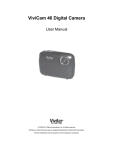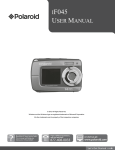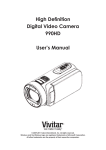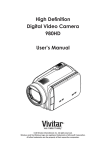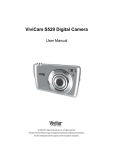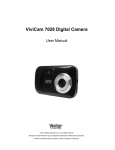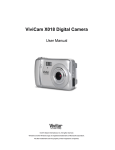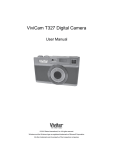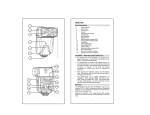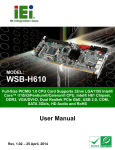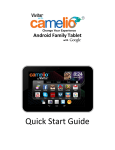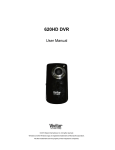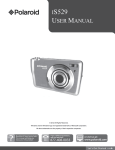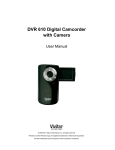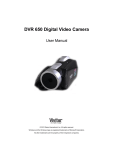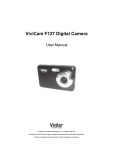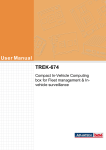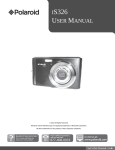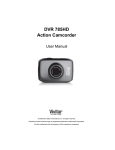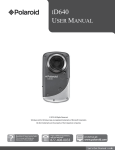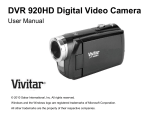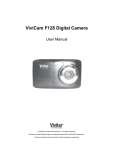Download DVR 892HD Digital Video Camera
Transcript
DVR 892HD Digital Video Camera User Manual © 2009-2011 Sakar International, Inc. All rights reserved. Windows and the Windows logo are registered trademarks of Microsoft Corporation. All other trademarks are the property of their respective companies. Contents Introduction ...........................................................................................................................................2 What‟s Included ....................................................................................................................................2 Camera Technical Specifications ..........................................................................................................3 Computer System Requirements – Windows........................................................................................4 Computer System Requirements – Macintosh ......................................................................................4 Parts of the Camera ..............................................................................................................................5 Initial Camera Setup .............................................................................................................................6 Powering ON/OFF Your Digital Video Camera ......................................................................................8 Changing DVR Mode ............................................................................................................................9 Navigating the Menus ...........................................................................................................................9 Video Capture Mode ...........................................................................................................................10 Video Playback Mode .........................................................................................................................13 Photo Capture Mode ...........................................................................................................................18 Photo Playback Mode .........................................................................................................................22 General Camera Settings....................................................................................................................25 Connecting the Digital Video Camera to a TV and HDTV ...................................................................30 Installing the Software .........................................................................................................................32 Connecting the Camera to the Computer............................................................................................34 Getting Photos and Videos from Your Camera to Your Computer .......................................................35 Getting Started! ...................................................................................................................................36 Transferring Images from my Camera to my Computer Manually .......................................................36 Camera Maintenance ..........................................................................................................................38 Sakar Warranty Card ..........................................................................................................................39 Technical Support ...............................................................................................................................39 Troubleshooting ..................................................................................................................................40 1 Introduction Thank you for purchasing this digital video camera. Everything you need to take quality digital photos and videos is included with your digital video camera. Vivitar makes capturing those special moments as easy as possible. Note: Your digital video camera needs an SD Memory card (up to 16GB) for normal use. SD Memory cards are not included and need to be purchased separately. SD/SDHC Class 2 and 4 memory cards are compatible. Using a different class of card may result in video distortion and skipping. Please read this manual carefully first in order to get the most out of your digital video camera. What‟s Included 1) Digital Camcorder with Built-In USB Connector 2) Rechargeable Lithium Battery 3) USB cable 4) AV Cable 5) Vivitar Experience Image Manager Software Installation CD 6) AC Adapter 7) Wrist Strap Note: SD Memory card not included. 2 Camera Technical Specifications Image Sensor CMOS Sensor Photo Resolution 1280X1024 (1.3MP) , 2048x1536 (3MP), 2592X1944 (5.0MP) Video Resolution 1280X720 (HD), VGA 640X480 Focus Range 120cm~infinite File Format JPEG (Photo) / AVI (Video) External Memory SD/MMC 128MB-16GB (Class 4 or higher) LCD Display 2.0 Inch TFT Lens f=3.1mm, F2.8 Zoom 4X Digital Zoom Exposure Auto White Balance Auto, Daylight, Cloudy, Tungsten, Fluorescent ISO Auto, 50, 100, 200, 400, 800 Scene Auto Language English, French, German, Spanish Flash 2 LED Flash lamps Frequency 60Hz Auto Power Off 3 Minutes Interface USB 2.0 High Speed Windows XP (SP 3), Vista (SP1) and Windows 7 ; System Requirements Mac OSX v10.5.x and above Microphone Yes Speaker Yes Battery 3.7V / 600mAh Lithium Battery (Rechargeable) Working Temperature 0~40C 3 Computer System Requirements – Windows To be able to download photos and videos to your PC, you will need the following minimum configuration: Microsoft® Windows XP with Service Pack 3, Windows Vista with Service Pack 1 or Windows 7 Pentium® 4 processor (or above) 512 MB of RAM, with 250 MB of free hard disk space 16-bit Color monitor, 1024 X 768 recommended screen resolution CD-ROM Drive QuickTime® 6 or higher Microsoft® Internet Explorer 7 or higher Windows Media Player 10 or higher DirectX 9 or higher Internet connection required Computer System Requirements – Macintosh To be able to download photos and videos to your Macintosh, you will need the following minimum configuration: Intel processor running Mac OS X v10.5.x or later 256 MB RAM, 250 MB free hard disk space Display: 1024 x 768 or higher-resolution monitor QuickTime® 6 or higher Internet connection required 4 Parts of the Camera 1. Power Button 12. SD Memory Card Slot 2. Shutter Button 13. USB Lever 3. MODE Button 14. USB Connector 4. MENU / Back Button 15. Microphone 5. Up / Zoom In Button 16. Speaker 6. Down / Zoom Out Button 17. Wrist Strap Connector 7. Right Button 18. Battery Compartment 8. Left / LED Light On-Off 19. AV Out Port 9. LED Indicator light 20. HDMI Port 10. LCD Screen 21. Tripod Mount 11. Lens 22. LED Light 5 Initial Camera Setup 1) Installing the Battery Press / slide down the battery cover and insert the included lithium battery. Align with correct polarity (+,-) of battery terminals. Close the battery cover. Make sure the battery has been inserted properly into your digital camera, according to the polarity shown inside the battery compartment. Note: Remove the battery from the camera when not in use for an extended period. Some camera features (Flash) will not work if the battery power level is low. When the battery power is low the battery icon turns red and the camera will automatically turn off a few seconds later. The energy status of the power is displayed on LCD as shown below: Full battery power Medium battery power Low battery power Charging the Battery To Charge the Battery: 1. Power off the camcorder. 2. Connect the camcorder using the USB built-in connector/USB cable to the computer‟s USB port or to the AC Adapter (which is then connected to a standard wall socket). 3. Allow the battery to charge for at least 3 hours before using the first time. 4. The charge light will turn off when the battery is fully charged. NOTE: While the device is recharging it cannot be used to capture images. 6 2) Installing the SD Memory Card IMPORTANT: It is recommended to use a Class 2, Class 4 SD card or higher SD card. Make sure a Class 2 or Class 4 (or higher) SD card (up to 16GB) has been properly inserted into your camera. SD card not included. To properly insert the SD Card: - Press the SD card into the slot in the direction shown on the camera. - Press the SD card until you hear a slight clicking sound. This indicates that the SD card has been inserted correctly. Note: After the camera is powered on, an SD icon will appear on the LCD display. If you do not see the SD icon on the display, please check if the card was inserted properly. Make sure the SD card is not locked (check the lock switch on the side of the SD card). If the SD card is locked this will prevent the camera from saving captured photos to the SD card. 3) Powering ON the camera Press the POWER button to turn on the camera. 7 4) Using the Camera Powering ON/OFF Your Digital Video Camera Make sure the battery has been inserted and charged properly. Make sure an SD card (Class 2 or Class 4) has been inserted into your camera. (SD card up to 16GB - SD Card not included) Powering the DVR ON Press and hold the Power button to turn your camera ON. The camera will be in Video Capture mode to start. Powering the DVR OFF While the camcorder is on, you can press and hold the Power button again at any point to turn your camera OFF. You will see a “Goodbye” splash screen and then the camcorder will power off completely. Note: Your digital video camera also has an Auto Power Off feature that will automatically turn off your camera after 1 minute that your camera is left idle. When the battery level is low, the camera will turn off automatically. This indicates that you must recharge the battery. 8 Changing DVR Mode Your digital video camera has three main modes to capture and view your images: 1) Video Capture Mode - Use this mode to capture videos with your camera. 2) Photo Capture Mode - Use this mode to capture photos with your camera. 3) Playback Mode (for photos and videos) - Use this mode to view the photos and videos you have already taken with your camera. When the camera is first powered ON, the Video Capture Mode will be active. To change the active camcorder mode, make sure the camcorder is powered ON and press the MODE button. When in Video Capture Mode, this icon will display on the top-left corner of the LCD display When in Photo Capture Mode, this icon will display on the top-left corner of the LCD display When in Playback Mode, this icon will display on the top-left corner of the LCD display Navigating the Menus 1) From the Video or Photo Capture Mode, press the MENU button to open the camcorder setting menus. 2) Press the UP or DOWN direction control button to scroll and highlight the desired menu. 3) Press the Shutter/OK or RIGHT button to view the selected submenu options. 4) Press the UP or DOWN direction control button to highlight a specific submenu option, then (if applicable) press the RIGHT or LEFT direction control button to toggle and select the submenu setting. 5) Press the Shutter/OK button to confirm and save your selected setting. 6) Press the MENU button at any time to exit the menu and submenu settings. 7) Remember that this setting will be saved by your camera until you manually change the setting or restore the camera‟s default factory settings. 9 Video Capture Mode The Video Capture Mode allows you to capture videos with your digital video camera. When first powered ON, the camcorder will be in Video Capture Mode. Taking a Video 1) While in Video Capture Mode use the LCD display to direct the camera at the scene you would like to capture. 2) Push the UP/Zoom In or DOWN/Zoom Out button to better set the camera display if desired. 3) Press the Shutter button to START the video capture. 4) The elapsed time will display on the top right corner of the LCD screen. A red Recording indicator will also appear on the LCD screen indicating that the record is in progress. 5) To STOP the video record, press the Shutter button again. 6) The video will automatically be saved to the camera‟s SD memory card. Note: The amount of recording time available for the resolution selected appears on the top of LCD screen. The lower the resolution setting the more recording time is available. However, videos recorded at lower resolution are of less quality than videos recorded at the higher resolution. Remember, the amount of time that you can capture videos also depends on the size of the SD memory card inserted as well as the video resolution selected. 10 Video Capture Mode Quick Function Buttons Your digital video recorder has a four-directional pad and additional buttons that functions as Quick Function buttons. Button LEFT + UP - Function LED Flash – On/Off Zooms in RIGHT Video Resolution – Changes between 720P and 640 Video Resolution DOWN Zooms out Other Starts and stops your video capture. Shutter/OK Confirms and saves your menu selection. Opens and exits the Video Capture and Camera Settings Menu options. MENU Note: To navigate through the Menus, use the Left, Up, Right, and Down directions control buttons. Toggles between the Video Capture Mode, Photo Capture Mode, and MODE Playback Mode. LED Flash Option To increase the lighting in dark situations, press the LEFT button to activate the 2 LED Flash Lights on the front of the camera. A flash icon appears on the LCD indicating the LED Flash is on. Press the LEFT button again to turn the LED Lights off. Video Capture Mode Menus Movie Size Menu The Movie Size menu allows you to choose the desired size of the images taken by your camera. Keep in mind that images with a higher resolution will also take up more of your camera‟s memory. 1) Press the MENU button to open the menus for the current mode. 2) Press the UP or DOWN direction control buttons to scroll through the menu options and select Movie Size. 11 3) Press the Shutter/OK button or the RIGHT button to open the submenu options. The Movie Size options include: 720P (HD) 1280 x 720 VGA 640 x 480 4) Press the UP or DOWN button to highlight the desired menu option. 5) Press the Shutter button to select and save the highlighted menu option. 6) A selected option icon will appear on the selected item. 7) Press the MENU button to exit the menu and return to the Video Capture mode. 8) An icon reflecting your selection will display on the LCD screen. NOTE: This setting will be remembered by your camera until you manually change the setting or restore the camera‟s default factory settings. White Balance Menu The White Balance feature allows your camera to adjust the coloring of the captured images depending on the type of light source in the current environment. Properly adjusting the White Balance setting to match your current environment will allow the camera to properly balance the colors in the images that are taken with your camera. 1) Press the MENU button to open the menus for the current mode. 2) Press the UP or DOWN direction control buttons to scroll through the menu options and select White Balance. 3) Press the Shutter/OK button or the RIGHT button to open the submenu options. The White Balance options include: Auto, Daylight, Cloudy, Tungsten, Fluorescent 4) Press the UP or DOWN button to highlight the desired menu option. 5) Press the Shutter button to select and save the highlighted menu option. 6) A selected option icon will appear on the selected item. 7) Press the MENU button to exit the menu and return to the Video Capture mode. NOTE: This setting will be remembered by your camera until you manually change the setting or restore the camera‟s default factory settings. 12 Video Playback Mode The Playback mode allows you to review photos and videos that you‟ve already taken with your digital video recorder. When you first turn on the camcorder, the camcorder will be in Video Capture mode by default. Press the MODE button once to open the Playback Mode. The Playback screen appears with the Playback icon appearing on the top left corner of the screen. Videos appear with a video icon on the bottom left of the LCD screen. Photos do not appear with an icon. Playing Videos on Your Digital Video Recorder 1) Select your Video: Once in Playback mode, press the LEFT or RIGHT direction buttons to scroll through the images on your digital video recorder‟s memory card until you find the video you would like to view. Each captured image (video/photo) is displayed on the LCD screen. 2) Playing your Selected Video: Press the Shutter/OK button to START playing the video. The video playing time is shown on the top right. Press the Shutter/OK button again to PAUSE/START again the video playback. Press the DOWN button to STOP the video playback. Press the RIGHT button to FAST FORWARD the playing video. Press the LEFT button to REWIND the video. Press the UP button to return back to normal speed. 13 Video Playback Mode Quick Function Buttons Your digital video recorder has a four-directional pad and additional buttons that functions as Quick Function buttons. Button LEFT Function - Displays the PREVIOUS image - Scrolls through your Thumbnail images - Rewinds during video playback - Scrolls through your Thumbnail images + UP - Returns video playback to normal speed playing (while rewinding or fast forwarding the video) RIGHT - Displays the NEXT image - Scrolls through your Thumbnail images - Fast forwards during video playback - DOWN - Opens the Thumbnail display - Stops the video playback Other - Starts and pauses the video playback Shutter/OK - Confirms and saves your menu selection - Opens selected image from the Thumbnail display Opens and exits the Video Playback and Camera Settings Menu options. MENU Note: To navigate through the Menus, use the Left, Up, Right, and Down directions control buttons. Toggles between the Video Capture Mode, Photo Capture Mode, and MODE Playback Mode. Thumbnail View Easily navigate and select the image you wish to view by using the Thumbnail View. The images on your camcorder will be displayed in a 3 X 3 matrix where you can use the direction buttons to scroll and select images from the thumbnails. 1) While in Playback Mode, press the DOWN button for the images to appear in Thumbnail View. 14 2) Use the UP/DOWN/LEFT/RIGHT direction control buttons to navigate the thumbnails and select the image you wish to view. Videos appear with a video icon. 3) Press the Shutter/OK button for the selected image to appear in full screen. Note: You can identify from the thumbnail the image type: AVI files display a video icon on the thumbnail image JPEG files do not have any icons on the thumbnail image Video Playback Mode Menus Protect Menu Pictures and videos taken with your camera can be protected or “locked” to prevent any deletion or alteration being made to the files. 1) Press the MENU button to open the menus for the current mode. 2) Press the UP or DOWN direction control buttons to scroll through the menu options and select Protect. 3) Press the Shutter/OK button or the RIGHT button to open the submenu options. The Protect options include: Single, Protect All, Unprotect All Single: Protects a Single Image (Video or Photo): Select „Single‟ and press the Shutter/OK button. Press „Yes‟ to lock the image. You can easily protect other images by pressing the LEFT and RIGHT buttons to select another image and then select „Yes‟ to protect the image you have selected. „Unprotect this file?‟ will appear on the protected image. To unlock the protected image, select „Yes‟. Protect All: Locks All Images (Videos and Photos) Select „Yes‟ to protect all files. Press the Shutter/OK button to confirm and lock all images. Unprotect All: Unlocks All Images (Videos and Photos) Select „Yes‟ to protect all files. Press the Shutter/OK button to confirm and unlock all of your images. 15 4) Press the MENU button to exit the menu and return to the previous mode. NOTE: Protected images appear with a lock icon on the image. The image will remain locked until you manually change the setting. Remember that you cannot delete videos or photos while they are protected. Delete Menu While in the Playback Mode, you can delete videos and photos from your camera through the Delete menu. 1) Select the image you would like to delete. 2) Press the MENU button to open the menus for the current mode. 3) Press the UP or DOWN direction control buttons to scroll through the menu options and select Delete. 4) Press the Shutter/OK button or the RIGHT button to open the submenu options. The Delete options include: Single, All Single: Deletes a Single Image: Select „Single‟ and press the Shutter/OK button. A confirmation window appears „Delete this file?‟ - To delete the selected file, highlight „Yes‟ and then press the Shutter/OK button. The image will automatically be deleted. - To exit without deleting the file, highlight „No‟ and then press the Shutter/OK button All: Deletes All Images (Videos and Photos): Select „All‟ and press the Shutter/OK button. A confirmation window appears „Delete all files?‟ - To delete all video and photos files saved to your SD memory Card, highlight „Yes‟ and then press the Shutter/OK button. The images will automatically be deleted. - To exit without deleting all of your files, highlight „No‟ and then press the Shutter/OK button. 5) Press the MENU button to exit the menu and return to the previous mode. 16 NOTE: Images that are protected cannot be deleted. First unprotect the image(s), and then select Delete in order to continue with deleting the file(s). Caution: Please use this Delete feature with care. Once images are deleted they are permanently removed from your SD memory card. Please make sure that you only use this feature once you have downloaded and saved all the images you wish to your computer. Volume Menu While in the Playback mode, you can control the volume heard during video playback. 1) Press the MENU button to open the menus for the current mode. 2) Press the UP or DOWN direction control buttons to scroll through the menu options and select Volume. 3) Press the Shutter/OK button or the RIGHT button to open the submenu options. The Volume options include: (lowest volume) 1 - 8 (highest volume) 4) Press the UP or DOWN button to highlight the desired menu option. 5) Press the Shutter button to select and save the highlighted menu option. 6) A selected option icon will appear on the selected item. 7) Press the MENU button to exit the menu and return to the Video Capture mode. NOTE: This setting will be remembered by your camera until you manually change the setting or restore the camera‟s default factory settings. 17 Photo Capture Mode The Photo Capture mode allows you to capture pictures with your digital video recorder. When the camcorder is first powered ON, the camcorder will be in Video Capture Mode by default. Press the MODE button twice to enter the Photo Capture mode. Taking a Picture 1) While in Photo Capture Mode use the LCD display to direct the camera at the scene you would like to capture. 2) The camera icon will appear on the top left corner of the LCD. 3) Push the UP/Zoom In or DOWN /Zoom Out button to better set the camera display if desired. 4) Press the Shutter button to capture your photo. 5) The photo will automatically be saved to the camera‟s SD memory card. 18 Photo Capture Quick Function Buttons Button LEFT + UP - Function LED Flash – On/Off Zooms in RIGHT Photo Resolution – Changes between 5M, 3M and 1.3M Photo Resolution DOWN Zooms out Other Captures your photo. Shutter/OK Confirms and saves your menu selection. Opens and exits the Photo Capture and Camera Settings Menu options. MENU Note: To navigate through the Menus, use the Left, Up, Right, and Down directions control buttons. Toggles between the Video Capture Mode, Photo Capture Mode, and MODE Playback Mode. LED Flash Option To increase the lighting in dark situations, press the LEFT button to activate the 2 LED Flash Lights on the front of the camera. A flash icon appears on the LCD indicating the LED Flash is on. Press the LEFT button again to turn the LED Lights off. Photo Capture Mode Menus Resolution Menu The Resolution menu allows you to choose the desired size of the images taken by your camera. Keep in mind that images with a higher resolution will also take up more of your camera‟s memory. 1) Press the MENU button to open the menus for the current mode. 2) Press the UP or DOWN direction control buttons to scroll through the menu options and select Resolution. 3) Press the Shutter/OK button or the RIGHT button to open the submenu options. 19 The Resolution options include: 5M 2592 x 1944 3M 2048x1536 1.3M 1280x1024 4) Press the UP or DOWN button to highlight the desired menu option. 5) Press the Shutter button to select and save the highlighted menu option. 6) A selected option icon will appear on the selected item. 7) Press the MENU button to exit the menu and return to the Video Capture mode. 8) An icon reflecting your selection will display on the LCD screen. NOTE: This setting will be remembered by your camera until you manually change the setting or restore the camera‟s default factory settings. White Balance Menu The White Balance feature allows your camera to adjust the coloring of the captured images depending on the type of light source in the current environment. Properly adjusting the White Balance setting to match your current environment will allow the camera to properly balance the colors in the images that are taken with your camera. 1) Press the MENU button to open the menus for the current mode. 2) Press the UP or DOWN direction control buttons to scroll through the menu options and select White Balance. 3) Press the Shutter/OK button or the RIGHT button to open the submenu options. The White Balance options include: Auto, Daylight, Cloudy, Tungsten, Fluorescent 4) Press the UP or DOWN button to highlight the desired menu option. 5) Press the Shutter button to select and save the highlighted menu option. 6) A selected option icon will appear on the selected item. 7) Press the MENU button to exit the menu and return to the Video Capture mode. NOTE: This setting will be remembered by your camera until you manually change the setting or restore the camera‟s default factory settings. 20 ISO Menu The ISO menu allows you to set the level of sensitivity that your camera has to light in the surrounding environment. When the ISO level is increased, the image sensor in your camera will be more sensitive to light and allow you to capture images in lower-light situations. The higher sensitivity to light however, may reduce the quality of the images that are taken. When the ISO is reduced, the image sensor in your camera will be less sensitive to light and will optimize the image quality in environments with bright lighting. 1) Press the MENU button to open the menus for the current mode. 2) Press the UP or DOWN direction control buttons to scroll through the menu options and select ISO. 3) Press the Shutter/OK button or the RIGHT button to open the submenu options. The ISO options include: Auto, ISO 50, ISO 100, ISO 200, ISO 400, ISO 800 4) Press the UP or DOWN button to highlight the desired menu option. 5) Press the Shutter button to select and save the highlighted menu option. 6) A selected option icon will appear on the selected item. 7) Press the MENU button to exit the menu and return to the Video Capture mode. NOTE: This setting will be remembered by your camera until you manually change the setting or restore the camera‟s default factory settings. Exposure Menu The Light Exposure setting helps you control the amount of light that enters your camera‟s lens. This setting should be adjusted when the environment is lighter or darker than normal. When the environment has more light than is needed, reduce the exposure setting (by using the negative - count) to reduce the amount of light allowed into the lens by your camera. If the environment has less light (darker) than is needed, increase the exposure setting (by using the positive + count) to increase the amount of light allowed into the lens by your camera. 1) Press the MENU button to open the menus for the current mode. 2) Press the UP or DOWN direction control buttons to scroll through the menu options and select Exposure. 3) Press the Shutter/OK button or the RIGHT button to open the submenu options. The Light Exposure options include: EV: -2.0, -1.7, -1.3, -1.0, -0,7, -0.3, +0.0, +0.3, +0.7, +1.0, +1.3, +1.7, +2.0 21 4) Press the UP or DOWN button to highlight the desired menu option. 5) Press the Shutter button to select and save the highlighted menu option. 6) A selected option icon will appear on the selected item. 7) Press the MENU button to exit the menu and return to the Video Capture mode. NOTE: This setting will be remembered by your camera until you manually change the setting or restore the camera‟s default factory settings. Photo Playback Mode The Playback mode allows you to review photos and videos that you‟ve already taken with your digital video recorder. When you first turn on the camcorder, the camcorder will be in Video Capture mode by default. Press the MODE button once to open the Playback Mode. The Playback screen appears with the Playback icon appearing on the top left corner of the screen. Videos appear with a video icon on the bottom left of the LCD screen. Photos do not appear with an icon. Viewing Captured Photos on Your Camcorder 1) Select and view your Image: Once in Playback mode, press the LEFT or RIGHT direction control button to scroll through the images on your digital video recorder‟s memory card until you find the image you would like to view. Each captured image (both videos and photos) is displayed on the LCD screen. 2) Zooming In/Out of your Selected Photo: Press the UP / Zoom In button to Zoom In and magnify the selected photo. Press the Shutter/OK button then press the LEFT/RIGHT/UP/DOWN direction control buttons to navigate around the zoomed photo. Press the Shutter/OK button to return to the zoomed view without the navigation option. Press the DOWN / Zoom Out button to Zoom Out of the selected photo that has been zoomed into. 22 Photo Playback Mode Quick Function Buttons Button LEFT Function - Displays the PREVIOUS image - Scrolls through your Thumbnail images + UP RIGHT - Scrolls through your Thumbnail images - Displays the NEXT image - Scrolls through your Thumbnail images - DOWN - Opens the Thumbnail display Other - Opens selected image from the Thumbnail display Shutter/OK - Confirms and saves your menu selection Opens and exits the Photo Playback and Camera Settings Menu options. MENU Note: To navigate through the Menus, use the Left, Up, Right, and Down directions control buttons. Toggles between the Video Capture Mode, Photo Capture Mode, and MODE Playback Mode. Protect Menu Pictures and videos taken with your camera can be protected or “locked” to prevent any deletion or alteration being made to the files. 1) Press the MENU button to open the menus for the current mode. 2) Press the UP or DOWN direction control buttons to scroll through the menu options and select Protect. 3) Press the Shutter/OK button or the RIGHT button to open the submenu options. The Protect options include: Single, Protect All, Unprotect All Single: Protects a Single Image (Video or Photo): Select „Single‟ and press the Shutter/OK button. Press „Yes‟ to lock the image. You can easily protect other images by pressing the LEFT and RIGHT buttons to select another image and then select „Yes‟ to protect the image you have selected. „Unprotect this file?‟ will appear on the protected image. To unlock the protected image, select „Yes‟. 23 Protect All: Locks All Images (Videos and Photos) Select „Yes‟ to protect all files. Press the Shutter/OK button to confirm and lock all images. Unprotect All: Unlocks All Images (Videos and Photos) Select „Yes‟ to protect all files. Press the Shutter/OK button to confirm and unlock all of your images. 4) Press the MENU button to exit the menu and return to the previous mode. NOTE: Protected images appear with a lock icon on the image. The image will remain locked until you manually change the setting. Remember that you cannot delete videos or photos while they are protected. Delete Menu While in the Playback Mode, you can delete videos and photos from your camera through the Delete menu. 1) Select the image you would like to delete. 2) Press the MENU button to open the menus for the current mode. 3) Press the UP or DOWN direction control buttons to scroll through the menu options and select Delete. 4) Press the Shutter/OK button or the RIGHT button to open the submenu options. The Delete options include: Single, All Single: Deletes a Single Image: Select „Single‟ and press the Shutter/OK button. A confirmation window appears „Delete this file?‟ - To delete the selected file, highlight „Yes‟ and then press the Shutter/OK button. The image will automatically be deleted. - To exit without deleting the file, highlight „No‟ and then press the Shutter/OK button All: Deletes All Images (Videos and Photos): Select „All‟ and press the Shutter/OK button. 24 A confirmation window appears „Delete all files?‟ - To delete all video and photos files saved to your SD memory Card, highlight „Yes‟ and then press the Shutter/OK button. The images will automatically be deleted. - To exit without deleting all of your files, highlight „No‟ and then press the Shutter/OK button. 5) Press the MENU button to exit the menu and return to the previous mode. NOTE: Images that are protected cannot be deleted. First unprotect the image(s), and then select Delete in order to continue with deleting the file(s). Caution: Please use this Delete feature with care. Once images are deleted they are permanently removed from your SD memory card. Please make sure that you only use this feature once you have downloaded and saved all the images you wish to your computer. General Camera Settings The General Camera Menu allows you to change the following camcorder settings: Light Frequency, Date & Time, Language, TV Out, USB, Format, Reset All To access the Menus for General Camera Settings: 1) Press MENU button from all modes (Video/Photo Capture Mode, Playback Mode). 2) Press the RIGHT button to select the Camera Settings Icon . Light Frequency Menu The options in the Frequency menu represent the frequency of the electrical current in fluorescent lighting sources in your locale. If your camera is set to a frequency that does not match your country‟s electric current, you may see flickering or waves on the images taken by your camera. The Light Frequency menu options include: 50Hz – UK, Europe and Australia 60Hz – US, Canada and South America (default setting) 1) Press the MENU button to open the menus for the current mode. 25 2) Press the UP or DOWN direction control buttons to scroll through the menu options and select Light Freq. 3) Press the Shutter/OK button or the RIGHT button to open the submenu options. 4) Press the UP or DOWN button to highlight the desired menu option. 5) Press the Shutter button to select and save the highlighted menu option. 6) A selected option icon will appear on the selected item. 7) Press the MENU button to exit the menu and return to the previous mode. Note: This setting will be remembered by your camera until you manually change the setting or restore the camera‟s default factory settings. Date & Time Menu The Date/Time menu allows you to set your camera‟s date and time as desired in order to document the date and time of the capture images. 1) Press the MENU button to open the menus for the current mode. 2) Press the UP or DOWN direction control buttons to scroll through the menu options and select Date & Time. 3) Set the Date and Time as desired by pressing the RIGHT and LEFT buttons to choose the specific setting and the UP and DOWN buttons to change each setting. 4) Once you have completed setting the time and date, press the Shutter/SET button to confirm and save the date and time. 5) Press the MENU button at any time to exit the menus and submenu settings. Note: This setting will be remembered by your camera until you manually change the setting or restore the camera‟s default factory settings. Language Menu You can select your digital video camera‟s language setting by selecting the desired language from the Language menu. The Language menu options include: English, French, German, Spanish 1) Press the MENU button to open the menus for the current mode. 26 2) Press the UP or DOWN direction control buttons to scroll through the menu options and select Language. 3) Press the Shutter/OK button or the RIGHT button to open the submenu options. 4) Press the UP or DOWN button to highlight the desired menu option. 5) Press the Shutter button to select and save the highlighted menu option. 6) A selected option icon will appear on the selected item. 7) Press the MENU button to exit the menu and return to the previous mode. Note: This setting will be remembered by your camera until you manually change the setting or restore the camera‟s default factory settings. TV Out Menu TV Out allows you to select the TV option appropriate for you to view your captured images on your television. See “Connecting the Digital Video Camera to a TV and HDTV” for further information on how to connect your digital video camera to your television. The TV Out menu options include: NTSC – television and video standard used in America, Canada (default setting) PAL – television and video standard used in Europe 1) Press the MENU button to open the menus for the current mode. 2) Press the UP or DOWN direction control buttons to scroll through the menu options and select TV Out. 3) Press the Shutter/OK button or the RIGHT button to open the submenu options. 4) Press the UP or DOWN button to highlight the desired menu option. 5) Press the Shutter button to select and save the highlighted menu option. 6) A selected option icon will appear on the selected item. 7) Press the MENU button to exit the menu and return to the previous mode. NOTE: This setting will be remembered by your camera until you manually change the setting or restore the camera‟s default factory settings. The HD1Z is set to NTSC which is standard in the United States. Do not change to PAL mode unless you are outside of the United States. 27 USB Menu The USB menu allows you to select what type of device you will be connecting to your camcorder. Your USB is set to Computer mode. This means that your computer will recognize your digital video camera when you plug it into the USB port of your computer. Please note that the Printer mode will only work with certain printers. Most printers will not recognize your digital video camera when you plug it into its USB port. The USB menu options include: Computer – selection when connecting your camcorder to your computer (default setting) Printer - selection when connecting your camcorder to your printer 1) Press the MENU button to open the menus for the current mode. 2) Press the UP or DOWN direction control buttons to scroll through the menu options and select USB. 3) Press the Shutter/OK button or the RIGHT button to open the submenu options. 4) Press the UP or DOWN button to highlight the desired menu option. 5) Press the Shutter button to select and save the highlighted menu option. 6) A selected option icon will appear on the selected item. 7) Press the MENU button to exit the menu and return to the previous mode. Format Menu You can use the Format menu to delete all of the content that is currently on your camera‟s memory card. Keep in mind that formatting the memory card will permanently delete all of the content on your camera‟s memory card. This option will delete all of the content at one time. If you would like to delete individual images, use the delete menu in the camera‟s Playback mode. The Format menu options include: Yes –formats your SD memory card and permanently delete all images No – exits without formatting your SD memory card 1) Press the MENU button to open the menus for the current mode. 2) Press the UP or DOWN direction control buttons to scroll through the menu options and select Format. 3) Press the Shutter/OK button or the RIGHT button to open the submenu options. 28 4) Press the UP or DOWN button to highlight the desired menu option. 5) Press the Shutter button to select and save the highlighted menu option. 6) A selected option icon will appear on the selected item. 7) Press the MENU button to exit the menu and return to the previous mode. Reset All Menu Use this menu to reset your camcorder settings to the Factory Default Settings. The Reset All menu options include: Yes – resets your camcorder to the default factory settings No – exits without resetting your camcorder to the default factory settings 1) Press the MENU button to open the menus for the current mode. 2) Press the UP or DOWN direction control buttons to scroll through the menu options and select Reset All. 3) Press the Shutter/OK button or the RIGHT button to open the submenu options. 4) Press the UP or DOWN button to highlight the desired menu option. 5) Press the Shutter button to select and save the highlighted menu option. 6) A selected option icon will appear on the selected item. 7) Press the MENU button to exit the menu and return to the previous mode. 29 Connecting the Digital Video Camera to a TV and HDTV Connecting the Camera to the TV The camera has an AV port to use your larger TV screen in place of the camera‟s LCD screen. On plugging the TV-out cable (supplied) to the cameras AV out jack, the LCD screen will turns blank. Use the camera as you would to capture and playback photos and videos. The images will appear on the TV instead of on the LCD screen. NOTE: The only limitation of using the TV screen is that the camera is now not portable. 1) Connect the camcorder to a TV via the TV-out cable (supplied). 2) Turn on the TV and the camera, and then set the TV to “AV” mode. 3) You will need to set the TV format on the camera to suit the TV format of your TV set. 4) Make sure the camera is set to the correct TV Output setting. On plugging in the TV out cable a message will appear on the LCD screen to select NTSC or PAL for the type of TV you are using. 5) Select the option as per the format of the TV set you are using and press the Shutter/OK button. 6) When the camera is set to Video or Photo Capture mode, you can preview the subjects you want to record or photograph on the TV screen. 7) When the camera is set to Playback mode, you can review all the photos and videos stored in the SD memory card on the TV. Connecting the Camera to the HDTV To view the high resolution quality videos recorded with your camera, connect the camera to an HDTV with the HDMI (purchased separately). On plugging the HDMI cable to the camera‟s HDMI port, the LCD screen turns blank. Use the camera as you would to capture and playback photos and videos. The images will appear on the HDTV instead of on the LCD screen. NOTE: The only limitation of using the HDTV screen is that the camera is now not portable. 30 1) Connect the camera to an HDTV with the HDMI cable. 2) Turn on the HDTV and switch to HDMI-mode. 3) Turn on the camera. When the camera is set to Video or Photo Capture mode, you can preview the subjects you want to record or photograph on the TV screen and view the recording on the TV. 4) When the camera is set to Playback mode, you can review all the stored photos and videos on the TV. 5) In Playback Mode, push the LEFT or RIGHT button to select the video file to view. Press the Shutter button to play the selected video file. Press it again to pause playing. Press the UP button to stop the video. 31 Installing the Software You must be connected to the internet to install and run the Vivitar Experience Image Manager Software. 1) Insert the installation CD into your CD-ROM drive. The installation screen should automatically open. 2) On PC: The Vivitar Experience Image Manager Installer window appears. If the window does not appear, open the application‟s CD/DVD drive and click on “Setup.exe” to launch the installer. 3) On Macintosh: Click the icon that appears on the desktop to install the Vivitar Experience Image Manager. 4) If you do not have internet access at the time of inserting the CD-ROM, connect to the internet and then click the “Install Vivitar Experience Image Manager” button to begin the installation. Note: If you do not have internet access, you can still download media from the camera. Click the “How to transfer photos and videos from my camera to my computer” button for instructions. 32 5) If you have internet access, the “Choose your language” window opens, choose your language and click “Next” to open the next window. 6) Select your camera model from the list and click “Next” to open the next window. 7) Click “Next” to confirm your camera model selection and to install the application. 8) Please wait while the application is being installed on your computer. 9) Please review the license terms. On PC and Macintosh: Click the “I accept the terms of this license agreement” and then click “Next” to continue. 10) On PC only: Let the “Vivitar Experience Image Manager” installer create the folder to where the program will be installed, and then click “Install”. 11) Please wait while the application continues the installation process on your computer. 12) On PC: Click the “Close” button when the installation is complete. The application will automatically open. 13) On Macintosh: Click the “Quit” button when the installation is complete. Click the “Launch Vivitar Experience Image Manager” to open the application 14) If you close the application you can run the Vivitar Experience Image Manager from the Programs (PC) or Application (Mac) menu on your computer. 33 Connecting the Camera to the Computer 1) Slide the USB switch up to reveal and extend the built-in USB connector. 2) Power the camcorder on. 3) Insert the camera‟s built-in USB connector to the computer‟s USB port or use the supplied USB extension cable to make the connection. 4) The first time you connect the device to the computer you will have to wait a few seconds until the computer recognizes the device. 34 Getting Photos and Videos from Your Camera to Your Computer An SD card needs to be inserted. Do not disconnect the cable during transfer. Doing so will cancel the transfer of any files on their way to your computer. 1) Select the “Get Images” button from the Main menu. 2) The “Get media from device” window opens. 3) You can select to download photos, videos or both. 4) Select your camera (removable disk) from the device window. If your camera is the only USB device connected then it will be selected automatically. 5) Select a location on the computer where to place the new photo and video files. 6) Add the new photo and video files to albums if desired. 7) Select to remove the media files from the selected device (removable disk) after the import. 8) Click the “Get Media” button to transfer the photos and videos from your camera to your computer. 9) A media download progress bar appears on the bottom left showing the number of media files downloading to your computer. A message appears when the download is complete. 10) The photo and video files that you selected are now downloaded to your computer to the selected folder and albums ready for your use. 35 Getting Started! Using the Vivitar Experience Image Manager, you can: Upload and manage photos and videos to and from the most popular photo sharing and social networking sites - Facebook, Flickr, Picasa, MySpace, Photobucket, Twitpic, Twitgoo and YouTube Seamlessly transfer photos and videos from one social network to another Organize your images by creating offline and online albums Edit images using automatic and manual tools Use automatic “Geotagging” with built in Google Maps For more details on how to use the Vivitar Experience Image Manager open the „Help Guide‟ from the Help menu or click the “Take a Tour” button on the application‟s Home page. Transferring Images from my Camera to my Computer Manually Transferring Photos and Videos: WINDOWS 1) Slide the USB switch up to reveal and extend the built-in USB connector. 2) Insert the camera‟s built-in USB connector to the computer‟s USB port or use the supplied USB extension cable to make the connection. 3) Power on the camcorder. 4) MSDC appears on the LCD. 5) A window appears with a list of options, select “Open folder to view files” and click OK. 6) Open the DCIM folder and the folder inside to view the media files. 7) Select the media and copy the files from this folder into your computer. Optionally, select the files and choose Copy from the Edit menu. Then select a folder and choose Paste from the Edit menu. 8) We recommend that you copy the images into the Pictures/My Pictures folder and the videos into the Videos/My Videos folder. 9) Do not disconnect the cable during transfer. Doing so will cancel the transfer of any files on their way to your computer. 36 Transferring Photos and Videos: MACINTOSH 1) Slide the USB switch up to reveal and extend the built-in USB connector. 2) Insert the camera‟s built-in USB connector to the computer‟s USB port or use the supplied USB extension cable to make the connection. 3) Power on the camcorder. 4) MSDC appears on the LCD. 5) The camera‟s device icon appears on the desktop. 6) Click on the device icon and open the DCIM folder and the folder inside to view the media files. 7) Select the files and drag them into your computer. Optionally, select the files and choose Copy from the Finder‟s Edit menu. Then select a folder and choose Paste from the Edit menu. 8) We recommend that you copy the images into the Pictures folder and the videos into the Movies folder. 9) Do not disconnect the cable during transfer. Doing so will cancel the transfer of any files on their way to your computer. Transferring Photos and Videos: Apple iPad NOTE: Please check your device packaging for compatibility with the iPad. Apple iPad Camera Connection: For models that are compatible with the iPad, photos and videos can be imported from your digital camera to your iPad by following either one of the options below: 1) Connecting your digital camera to your iPad using an iPad Camera Connector: Plug the Camera Connector into the dock connector port on your iPad, then attach your digital camera using a USB cable (included) to the Camera Connector. NOTE: iPad Camera Connector not included. This may be purchased separately. 2) Using an iPad SD Card Reader: Connect the SD Card Reader to your iPad, then insert your digital camera's SD card into the slot to import photos and videos directly from your camera's SD card. NOTE: iPad SD Card Reader not included. This may be purchased separately. After you make the connection, your iPad automatically opens the Photos application, which lets you choose which photos and videos to import, then organizes them into albums. 37 Camera Maintenance The digital video camera is a delicate device. Please handle your digital video camera with care to avoid damaging it. Do not expose your digital video camera to heat sources. This digital video camera is suitable for environments between 0 °- 40 ° C or 32 °-104 ° F. Do not use you digital video camera in wet or moist conditions. Never open the housing of the digital video camera as some parts may cause an electrical shock. To clean the lens, the first step is to blow away dust from the surface. After doing so, use a cloth or tissue to wipe the lens. If necessary, use lens cleanser. Avoid touching the lens with your fingers. When left idle for long periods, remove the battery from your digital video camera and store it in a dry and dark place. The camcorder does not function as a recording device when the USB Adapter is used for charging the battery. 38 Sakar Warranty Card This warranty covers for the original consumer purchaser only and is not transferable. Products that fail to function properly UNDER NORMAL USAGE, due to defects in material or workmanship will be repaired at no charge for parts or labor for a period of one year. What Is Not Covered By Warranty: Damages or malfunctions not resulting from defects in material or workmanship and damages or malfunctions from other than normal use, including but not limited to, repair by unauthorized parties, tampering, modification or accident. What To Do When Service Is Required: When returning your defective product (postage pre-paid) for service, your package should include: 1) Copy of original bill of sale 2) A detailed written description of the problem. 3) Your return address and telephone number (Daytime) MAIL TO ADDRESS BELOW: Sakar US Sakar UK/Europe Sakar Australia Sakar International Attention: Service Department Return faulty camera Attention: Service Department 2D, Siskin Parkway East to the Refund 195 Carter Drive 4020 Middlemarch Business Park Counter at the store Edison, NJ Coventry, CV3 4PE where purchased 08817 Technical Support For technical support issues please visit our website at www.vivitar.com. You can find manuals, software and FAQ‟s at the website. Can‟t find what you are looking for? E-mail us at [email protected] and one of our technical support team members will answer your questions. For phone support in the US please call 1-800-592-9541, in the UK call 0800 917 4831, in Australia call 1800-006-614. If you would like to call from anywhere else, please visit www.vivitar.com your local toll free number. 39 or Troubleshooting Q: I have taken photos and selected the “Get Images” button. I get a message that the images were successfully transferred but the photos do not appear on my computer. What do I do? First ensure that you have in fact taken photos. Press the Shutter button to take some sample photos and then try downloading them again. With test photos if the camera powers off before you upload them to the computer the photos are not stored in the camera‟s memory. These photos should be uploaded quickly before the camera powers off. If the photos are saved to the SD memory card then all the photos should appear. Q: How do I make sure I don‟t lose important pictures? This camera requires an SD card for normal use. If the camera powers off nothing will happen to the images stored on the SD memory card. We recommend always downloading your photos to your computer as soon as possible to prevent unintentional data loss. Q: I deleted images using the Vivitar Experience Image Manager. The images were also deleted from my computer. How do I recover images that I accidently deleted? All images deleted using the Vivitar Experience Image Manager are sent to your computer‟s Recycle or Trash Bin and can be retrieved from there. Waste Electrical and Electronic Equipment (WEEE) In accordance with European Directive 2002/96/EC on Waste Electrical and Electronic Equipment (WEEE), the presence of the above symbol on the product or its packaging indicates that the used and end of life electrical and electronic equipment should not be disposed of in household waste. For the proper disposal, treatment, recovery and recycling, please take this product to designated collection points. Disposing of th is product correctly will help to save valuable resources and prevent any potential adverse effects on human health and the envir onment which could otherwise arise from inappropriate waste disposal and handling. Please contact your local authority for further details of your nearest designated collection point. Penalties may be applicable for incorrect disposal of this waste in accordance with national legislation. DVR892HD-081611TA 40 FW: 2HD1ZFJG5-122Q









































